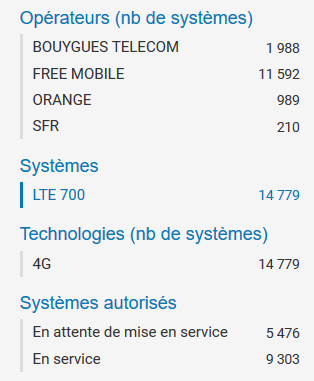Bands used in metropolitan France by Orange, SFR, Bouygues Télécom and Free:
| Standard | Frequency/Band | PLS8-E | BM818-E1 |
|---|---|---|---|
| GSM/GPRS/EDGE | EGSM 900MHz | X | X |
| DCS* 1800MHz | X | X | |
| HSPA+/WCDMA | B1 2100MHz | X | X |
| B8 900MHz | X | X | |
| LTE-FDD | B1 2100MHz¹ | X | X |
| B3 1800MHz | X | X | |
| B7 2600MHz | X | X | |
| B20 800MHz | X | X | |
| B28 700MHz | — | — | |
| TDD-LTE | — |
" * except Bouygues Télécom
Others Bands covered by modems but unused in metropolitan France:
| Standard | Frequency/Band | PLS8-E | BM818-E1 |
|---|---|---|---|
| GSM/GPRS/EDGE | GSM 850MHz | — | X |
| PCS 1900MHz | — | X | |
| HSPA+/WCDMA | B2 1900MHz | — | X |
| B3 1800MHz | X | — | |
| B5 850MHz | — | X | |
| LTE-FDD | B2 1900MHz | — | X |
| B5 850MHz | — | X | |
| B8 900MHz | X | X | |
| TDD-LTE | B38 2600MHz | — | X |
| B40 2300MHz | — | X | |
| B41 2500MHz | — | X |
Percentage of systems authorized by ANFR using this LTE-FDD band for a given provider:
| LTE-FDD Band | Orange | SFR | Bouygues Télécom | Free |
|---|---|---|---|---|
| B1 2100MHz | 15,8% (9 277) | 13,7% (6 226) | 8.9% (3 896) | 0,0% (1) |
| B3 1800MHz | 28,6% (16 799) | 28,7% (13 075) | 28,7% (12 505) | 36,8% (15 894) |
| B7 2600MHz | 18,1% (10 676) | 16,7% (7 595) | 16,1% (6 995) | 36,3% (15 720) |
| B20 800MHz | 35,8% (21 080) | 40,4% (18 402) | 41,7% (18 183) | 0,1% (41) |
| B28 700MHz | 1,7% (989) | 0,5% (210) | 4,6% (1 988) | 26,8% (11 592) |
Please, double check for mistakes.
Sources:
https://www.frequencycheck.com/countries/france?c_id=1621544
https://www.gemalto.com/brochures-site/download-site/Documents/M2M_PLS8_datasheet.pdf
http://www.broadmobi.com/en/module_show.php?id=18
You can also consider the coverage:
¹ Edit:
Add LTE-FDD B1 2100MHz band for Orange and SFR, source
² Edit:
Add Percentage of systems authorized by ANFR using this LTE-FDD band for a given provider. An authorized system is not necessarily in service. source (08/08/2019)
Edit (26/09/2019) : The Librem 5 in France, which modem?

